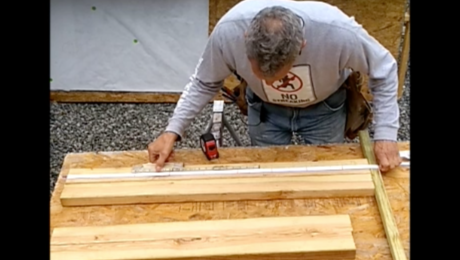I am trying to strip down to bare wood the exterior side of the entry way to my 93 year old house. There are numerous coats of paint, many that contain lead.
I have stripped paint numerous times previously but find that no matter what method I use, it is at best, a modest pain in the rear. But I am posting because I am always open to new methods/ideas.
My method for this project is to put Peel Away 6 on the top coat of paint, scrape off after 24 hours, and then use my infrared heat gun (www.silentpaintremover.com) to get at what is left (I find that Peel Away 6 really only removes 1 layer at a time). I use a really sharp scraper at all times. After these two steps, I still find that there is often a coat of varnish remaining underneath and/or white crusty substance that make me think plaster somehow got on the woodwork. It is the varnish and/or the white crusty plaster-like substance that stands between me and the bare wood in many spots.
Does anyone out there have tried and true methods that they swear by? Does anyone have experience with the Metabo Paint Stripper LF 724 S? (http://www.metabousa.com/metabo/handgefuehrte/us/en/produkte/paintremovers/paintremoverlf724s_6_00724_42.html)
I would like to have the option of putting a natural wood finish on my house’s oak entry way, which is now covered in many coats of white, gloppy paint. Perhaps it is a pipe dream but any experiences/methods are appreciated.



















Replies
I've got a project coming up and am looking into the same type items. The client wants safe enviro friendly products and has suggested
http://www.ecosafetyproducts.com/ProductDetails.asp?ProductCode=ES%2DSOY%2DE3005
But the friends here say it may be to thin, slow and not complete. What ever you do grinding and heat are not safe ways to remove lead based paints and the bottom most coats surely are the leadiest, (sorry).
Keep the surface wet and just scrape or sand but keep the surface wet so there is no movement air born. Remove all fabrics and furniture from the area and mask and film cover all openings into each room. If there is carpet near by film cover it all.
As to the door itself I'm taking down all their doors and sending them to a professional stripper. If I can remove all the trim and jambs I'm going to send them out also.
As for what I can't send out I'm going to get me a bench and set my big arse down and spritz, scrape and spritz and scrape again till I'm done.
Ya there paying me hourly.
I've had very good results using the 3M paint stripper. Glop it on evenly, then press waxed paper onto it to keep it wet longer. Let it sit until it just starts to dry; use putty knife to remove.
For reference, I've used this primarily on horizontal surfaces (e.g., doors lying on saw horses) that I could leave in a dark corner of our garage overnight. Sometimes I use a second application in spots; mostly it's ready for sanding.
Kathleen
Kathleen,
What's the particular name of the 3M paint stripper? Do you use any wax paper or does 3M require its own proprietary paper for it to work?
That's great if you can get to sanding after that one application. Approximately how many layers were you stripping?
Joel
I believe the name is "3M Safe Stripper"--mine came in a black plastic jug from WalMart. Orange gloppy semi-gel stuff.
Waxed paper is just the basic stuff you get at the grocery store. This was a solution to trying to strip a door in the summer in the desert--shade simply wasn't enough to keep stripper wet long enough for it to work. Twelve or so hours seemed to work well--put it on in the evening, remove mid-morning next day.
The idea came from a "This Old House" episode where they used a special stripper and paper combination, but I knew there'd be no place within 180-mile radius that would have anything that specialized. Have also used aluminum foil (did not seem to react with the stripper) and butcher paper (waxy side to the stripper). Aluminum foil is expensive but I've also used it over waxed paper to further retard evaporation--this way it can be reused.
Have not done anything really hard--several doors with 2-3 layers of paint. One door had more layers, but by the time I tried this method I'd already used some stripper (that dried too fast), done some sanding, and scraped a bit--don't know how to count that one.
Please note that it does NOT remove stain well, and the orange gel might change the color if you have light colored wood--be sure to test.
Kathleen
< Does anyone have experience with the Metabo Paint Stripper LF 724 S? >
Yes, I have one. It's fast but it's really easy to leave a semi-circular 'imprint' where you start each pass, if you're not careful.
Search the archives for more info.
If you are ending up with a layer of "varnish" left, I'd bet it is shellac. Shellac actually makes a great release agent for the paint, but will stay behind with regular removers. Denatured alcohol will remove the shellac. Use a shallow pan and scrubbie pads or steel wool to remove the shellac.
Why are you doing the Peel-Away at all if it isn't removing more layers? Go straight to the infared remover.
We have some woodwork with a creamy substance at the bottom. Not sure what it is, but it is a bear to remove. Hi heat, fast, is the only thing so far.
B,
Thanks for the tips on the denatured alchohol. I am certainly going to have to give that a try.
I haven't been using the infrared heat gun on the top coat of glossy paint because I've found that the Peel Away works easier on that coat. I don't know why - perhaps I'm not holding the heat gun over the area long enough or I haven't given it sufficient time to heat up. It seems that after 20 minutes of being on, the heat gun really starts to work well.
Is the creamy substance that you're encountering hardened? If so, I think that I am encountering the exact same thing. It is that stuff that is standing between me and a fairly nice piece of raw wood.
If you find anything that works well on that creamy layer, let me know. I will do the same.
The creamy stuff hardens QUICKLY after heating. That's why I've found high heat and scrape fast to get it off. Not only does it harden, it sticks back.If you do a search here, I know of at least one other person who has run into this. A builder in Seattle. We've discussed it before.
I've been told by several old house experts that that creamy layer is probably the original paint.
Daniel Neumansky
Restoring our second Victorian home this time in Alamdea CA. Check out the blog http://www.chezneumansky.blogspot.com/
Oakland CA
Crazy Homeowner-Victorian Restorer
Yeah, but what kind of paint?One person suggested milk paint, as it is protein based and not hydrocarbon, so the strippers don't act on it, unless you get enzyme ones.
<<< I haven't been using the infrared heat gun on the top coat of glossy paint because I've found that the Peel Away works easier on that coat. I don't know why - perhaps I'm not holding the heat gun over the area long enough or I haven't given it sufficient time to heat up. It seems that after 20 minutes of being on, the heat gun really starts to work well.>>>
I have used the SPR to remove paint on most of my 1890's house. In my experience the SPR removed all 9 layers of paint at once from my clapboards. It seems like the IR rays go through the paint and heat up the wood, which then releases the paint. I had some spots were the previous homeowner had scraped down to bare wood and used primer. The white primer did not come off with the heat gun, other than that it all came off at once. Are you uses a good pull scraper with a triangular blade?
Mike K
Aurora, IL
B,
Re: that "creamy layer of paint." I was working on my front entryway yesterday trying to get the creamy spots off of the woodwork. They are hard and resemble plaster. A contractor that happened to be working on a house next door introduced me to a scraper he uses to install hardwood floors and stairways. He took the scraper and scraped the layer right off. He said that the scraper costs about $7 at the wholesale supply place he frequents. The scraper simply consists of a wooden handle that you pull with a steel blade mounted on the end. He uses a bastard file to sharpen it.
This has been the best way I've found to get the bottom spots off that aren't moving after work with the heat gun and chemical stripper.
Anyway, I thought I would pass this along.
Pretty much similar to what I do, but the problem is in the detailed molding areas. We have that three grove profile trim stuff, and getting it out of there is a real pain. I generally use the Pro-Prep scrapers, but I got to hit it fast after heating or it sticks back on.
Anything that creates dust or vapor will release some of the lead into the air. Use chemical strippers and scrape it off, put it in a container and let it dry, then dispose of it correctly. Citrus Strip works pretty well. It's not the cheapest but it works. I have completely stripped several doors with it and. along with the carbide scraper and several other tools, everything came out looking great.